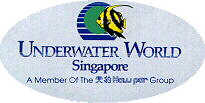OTGV #50 - Biodiversity& Zoo -2
Each year the living things that share our planet get lesser and lesser.
The way of the dodo is the path most travelled for those organism that aren't human.
Will the zoological gardens and marine parks of the world be the eventual resting place of some species?
Join me Chong Ching Liang as I examine the debate of zoos and aquariums as conservation agencies.
"We again, call for the Underwater World to release 4 dolphins back to
That's Louis Ng, the president of Acres, a local Animal Rights group.
Underwater World says it seeks to help prevent the extinction of the highly endangered Indo-pacific humpback or pink dolphins.
Mr Peter Dollinger, the Director of the Geneva-based World Association of Zoos and Aquariums thinks his members have a role to play.
"Today almost every species can be successfully kept and under conditions where they are not damage. And it is always been claimed by animal rights people that these species would not be suitable for re-introduction. But obviously this is not true because we have about 200 programmes for 200 species that are re-introduced and these are ex-situ bred animals. So apart from big whales where it is technically not possible or some other marine life , deep sea fishes, almost all species can be kept."
Ex-situ as opposed to in-situ conservation refers to conservation away from the original environment.
But ex-situ conservation has its detractors.
Mr Louis Lim explains why he is against Underwater World keeping their pink dolphins that had been caught from the wild.
"If you look at the dolphins themselves, anatomically and anamorphically, they are all built for swimming at fast speed. So they're all built for large home ranges -- 30 to 400 square kilometres in the wild. When you take such animals with such large home ranges and confine them in captivity in 0.0003 percent of what they are used to in the last 15 years, it is strictly detrimental to their welfare."
Louis Ng and his team say they won't have a problem if Underwater World or institutions such as them bought animals that had been bred in captivity.
His explains this opposition.
"If you say now that there is too few left in the wild and if you take from the wild, you are putting it in a higher risk of attention. One dolphin has already died here, Underwater World spend 3 million dollars to build this dolphin lagoon. If you put the 3 million into in-situ conservation, I think there will be more success. If dolphinarium, if they take captive bred dolphins, they made a lot of money, they put the money back into research, they put the money back into in-situ conservation, they release some of the animals which other zoos have done, then perhaps that is a compromise."
But if the natural habitats of endangered species are disappearing fast with no real conservation efforts to prevent this, these animals will disappear without the intervention.
Dr Shawn Lum, Vice President of the Nature Society and a trainer of biologist teachers, muses on this problem.
"It’s a dilemma that people face. Hopefully the zoos do the research to learn how these animals can do well in captivity, to understand their physiology so that we can have a successful breeding programme and then integrate it with a programme for eventual re-introduction to the wild. Otherwise if you just keep zoo population going, then they just in a way become just like museum pieces if you just let them disappear in the wild."
Mr Dollinger says that zoos and aquariums have slowly picked up the role of repopulating the wild.
He explains.
"There could be project that are going on in an existing reserve, or there are also cases where they have purchase lands whether in their own country or in there country or run a consortium with the nature conservation authority of the country concerned to jointly manage the reserve. Ten years ago they may just provide just money for some conservation organisation and then they lost control of what was going on but now the trend is very clearly that we try to get permanently or long term involved."
Animal lover will tell you that an animal in the zoos or aquariums isn't worth anything unless efforts are made to preserve the wild populations.
Dr Shawn Lum says these institutions must educate the public so that collectively they can exert their political will to change the world.
"When I was a kid, I grew up in
It's not impossible.
Companies have been forced to implement dolphin safe fishing methods so that consumers will buy their tinned fish again.
And, the meek may yet inherit the Earth.
This is Chong Ching Liang for Newsradio 938.
===============================================
Newsradio 938 (now 938Live)

http://www.938live.sg/
World Association of Zoos and Aquariums

http://www.waza.org
Nature Society Singapore

http://www.nss.org.sg/
Animal Concerns, Research & Educations Society

http://www.acres.org.sg/
Underwater World, Singapore

http://www.underwaterworld.com.sg/


0 Comments:
Post a Comment
<< Home